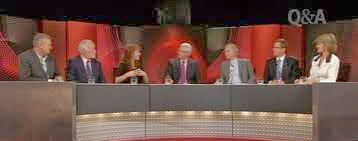The logic of popular debates about gender inequality
It’s time that media discussion and debate about gender inequality
establishes some ground rules, namely logical consistency. Reading Clementine
Ford’s opinion piece ‘Male
privilege extends beyond the airwaves,’ written for the ABC’s drum, brings
this to bear.
This is a cut-and-dry feminist argument that the lack of women in
Australian media is detrimental to female equality in society at large. The
evidence offered is quite staggering. For instance in talk back radio this time
last year there were only 17 female hosts to 123 male hosts. Moreover, Ford’s
critique of the ABC program Q&A is spot on, which regularly populates its
panel of experts with a 4:2 ratio of men to women. Interesting she ‘guesses’
that if this ratio was in reverse, there would be a vocal audience backlash. To
this last point I would caution that conjecture is not evidence.
It is, however, the logical inconsistency of Ford’s central proposition
with which I take issue. Ford states: ‘Firstly, it is illogical and
intellectually dishonest to treat women as if we are one homogenous group with
a single set of characteristics to identify us.’
Throughout the article however, men are largely referred to as a single
group united by their social privilege. This is fairly common amongst feminist
arguments calling for an end to patriarchy and female inequality.
If it holds that women are characterised by diversity, it is
illogical to proceed with your argument against inequality as if men are not also
characterised by diversity.
Public debate about the representation of gender in media needs to
reassess its position and adopt a more sophisticated approach to the workings
of power. While public figures that adopt the role of mediator and adjudicator
in programs like Tony Jones in Q&A clearly share physical characteristics,
this is not evidence that all men are privileged within society.
Rather I would suggest that white, middle aged men with a quality
education and a relatively affluent background are a particular demographic
amongst Australian men who are more likely to enjoy a public life and
profession. This is because their values are more likely to accord with those
who own and run media, and because they are more likely to have the education
and connections that grant them access to this type of profession. It is these
types of factors that shape and reinforce public perception that a reasonable
adjudicator of public debate is a well-educated white and middle-aged man, not
a deeply ingrained distrust of a female agenda.
To my mind, there are two important points to take from this.
First, logical consistency must be established, along with a recognition
that both men, women and indeed, transgender people, suffer inequality, though
in different ways and in different contexts.
Second, those who seek change must take responsibility for creating
change. Women who want these types of public roles should take advantage of the
current changes in media production and consumption to carve out a public voice
and cultivate new audiences. People are turning to the internet in droves to
source their news, and for a variety of reasons. Examples abound of interested
and engaged individuals who share their expertise on you tube, in blogs and
online publications, and in so doing have built a solid reputation and loyal
audiences.
If traditional and male dominated media outlets lock women out, don't rely on them. Rather than insisting on costly and ineffective public action, use your unique feminine accumen to innovate new solutions (and don’t conveniently sacrifice logical consistency, it only undermines your own position).
If traditional and male dominated media outlets lock women out, don't rely on them. Rather than insisting on costly and ineffective public action, use your unique feminine accumen to innovate new solutions (and don’t conveniently sacrifice logical consistency, it only undermines your own position).




Comments
Post a Comment